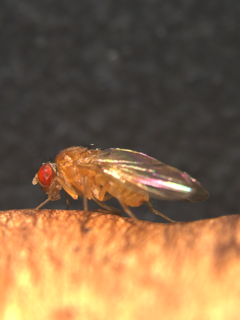
Drosophila is a genus of flies, belonging to the family Drosophilidae, whose members are often called "small fruit flies" or pomace flies, vinegar flies, or wine flies, a reference to the characteristic of many species to linger around overripe or rotting fruit. They should not be confused with the Tephritidae, a related family, which are also called fruit flies ; tephritids feed primarily on unripe or ripe fruit, with many species being regarded as destructive agricultural pests, especially the Mediterranean fruit fly.

The Drosophilinae are the largest subfamily in the Drosophilidae. The other subfamily is the Steganinae.

The immigrans-tripunctata radiation is a speciose lineage of Drosophila flies, including over 300 species. The immigrans-tripunctata radiation is a sister lineage to most other members of the subgenus Drosophila. A number of species have had their genomes or transcriptomes sequenced for evolutionary studies using Drosophila.

The genus Zaprionus belongs to the family fruit fly Drosophilidae and is positioned within the paraphyletic genus Drosophila. All species are easily recognized by the white longitudinal stripes across the head and thorax. The genus is subdivided in two subgenera, based on the presence of an even or odd number of white stripes. The species of the genus can be found in African and Southern Asia. One species, Zaprionus indianus, has invaded the New World.
Drosophila elegans is a flower-feeding species of fruit flies, belonging to the family Drosophilidae. It is found in Taiwan and the Philippines in Asia.
Drosophila colorata is a species of vinegar fly in the family Drosophilidae. It is found in the United States.

Drosophila repleta is a species of vinegar fly in the family Drosophilidae.

Chymomyza is a genus of vinegar flies.
Drosophila tripunctata is a species of vinegar fly in the Immigrans-tripunctata radiation of the subgenus Drosophila.

Drosophila immigrans is a species of vinegar fly in the family Drosophilidae. Drosophila immigrans is a member of the Immigrans-tripunctata radiation of the subgenus Drosophila. It is related to the Drosophila quinaria and Drosophila testacea species groups, and the fellow Immigrans species group member Drosophila albomicans. Drosophila immigrans has been used in evolutionary studies to understand how viruses evolve with their hosts.
Drosophila quinaria is a species of fruit fly in the Drosophila quinaria species group. Most Quinaria group species feed largely on mushrooms. However D. quinaria instead eats decaying vegetative matter, a trait it evolved independently.
Drosophila cardini is a species of fruit fly in the Drosophila cardini species group.
Drosophila deflecta is a species of fruit fly in the Drosophila quinaria species group.

Lordiphosa is a genus of fly in the family Drosophilidae.

Drosophila testacea is a member of the testacea species group of Drosophila. Testacea species are specialist fruit flies that breed on the fruiting bodies of mushrooms. Drosophila testacea can be found in temperate regions of Europe, extending to east Asia. Drosophila testacea and Drosophila orientacea can produce viable hybrids, though they are separated by geography and behavioural barriers. Drosophila testacea females will also readily mate with Drosophila neotestacea males, but viable hybrids are never produced. This hybrid inviability ) may be due to selfish X chromosomes and co-evolved suppressors. Alternately, differences in sex pheromone reception could underlie female readiness and male willingness to copulate.
Drosophila orientacea is a member of the testacea species group of Drosophila. Testacea species are specialist fruit flies that breed on the fruiting bodies of mushrooms. Drosophila orientacea is found in northern Japan on the island of Hokkaido. However, the European species Drosophila testacea and D. orientacea can produce viable hybrids, blurring the level of speciation between the two species. While viable hybrids are produced, extreme behavioural barriers likely prevent mating in the wild. While D. orientacea readily mates with Drosophila neotestacea, viable hybrids are never produced. This hybrid inviability may be due either to issues during copulation, or selfish X chromosomes and co-evolved suppressors.

The Drosophila testacea species group belongs to the Immigrans-tripunctata radiation of the subgenus Drosophila, and contains 4 species: Drosophila putrida, Drosophila neotestacea, Drosophila testacea, and Drosophila orientacea. Testacea species are specialist mushroom-feeding flies, and can metabolize toxic compounds in Amanita mushrooms. The Testacea species group is studied for its specialist ecology, population genetics, and bacterial endosymbionts. The North American species Drosophila neotestacea is perhaps the best-studied of the group for its interactions with parasitic wasps and nematodes, bacterial endosymbionts, and trypanosomatid parasites. Of note, selfish X chromosomes have been discovered in three of the four Testacea group species.
Drosophila albomicans is a species of vinegar fly in the family Drosophilidae. Drosophila albomicans is a member of the Immigrans-tripunctata radiation of the subgenus Drosophila. The D. albomicans genome was first sequenced in 2012 to study the evolution of novel sex chromosomes, a characteristic this species is best known for. One commonly accepted definition of the biological species concept is that individuals or populations are members of different species if they are incapable of successful interbreeding. While D. albomicans and Drosophila nasuta are commonly referred to as distinct species, there appears to be little to no sexual isolation between these two Drosophila species. Instead, behavioural differences appear to reproductively isolate these two species.

The Drosophila immigrans species group is a polyphyletic and speciose lineage of Drosophila flies, including over 100 species. Immigrans species belong to the Immigrans-tripunctata radiation of the subgenus Drosophila. Well-described species include Drosophila immigrans, and the sister species Drosophila albomicans and Drosophila nasuta. The genome of D. albomicans was sequenced in 2012 in an effort to characterize novel sex chromosome development in D. albomicans. Immigrans group species are related to mushroom-breeding Drosophila of the Quinaria and Testacea species groups.









